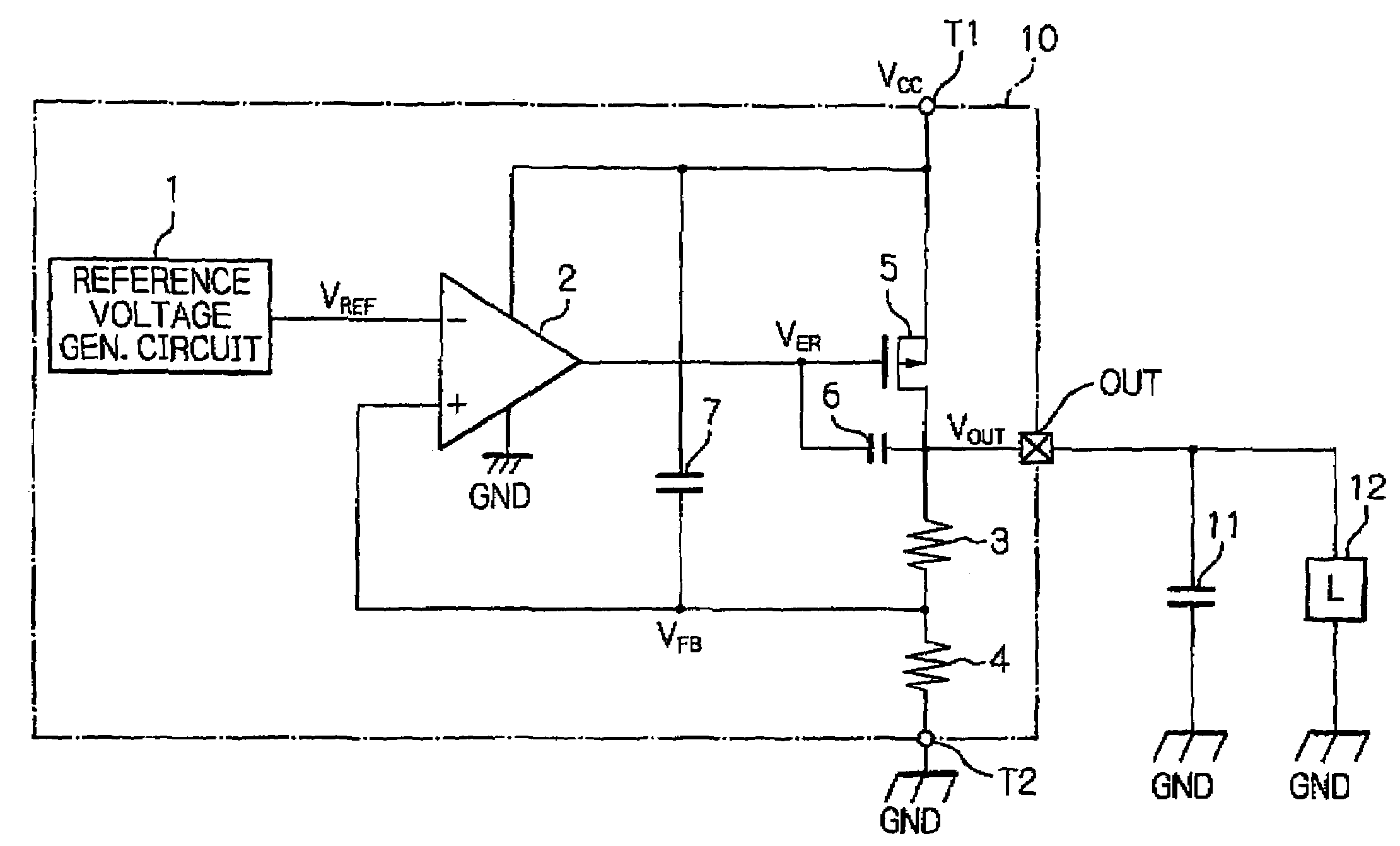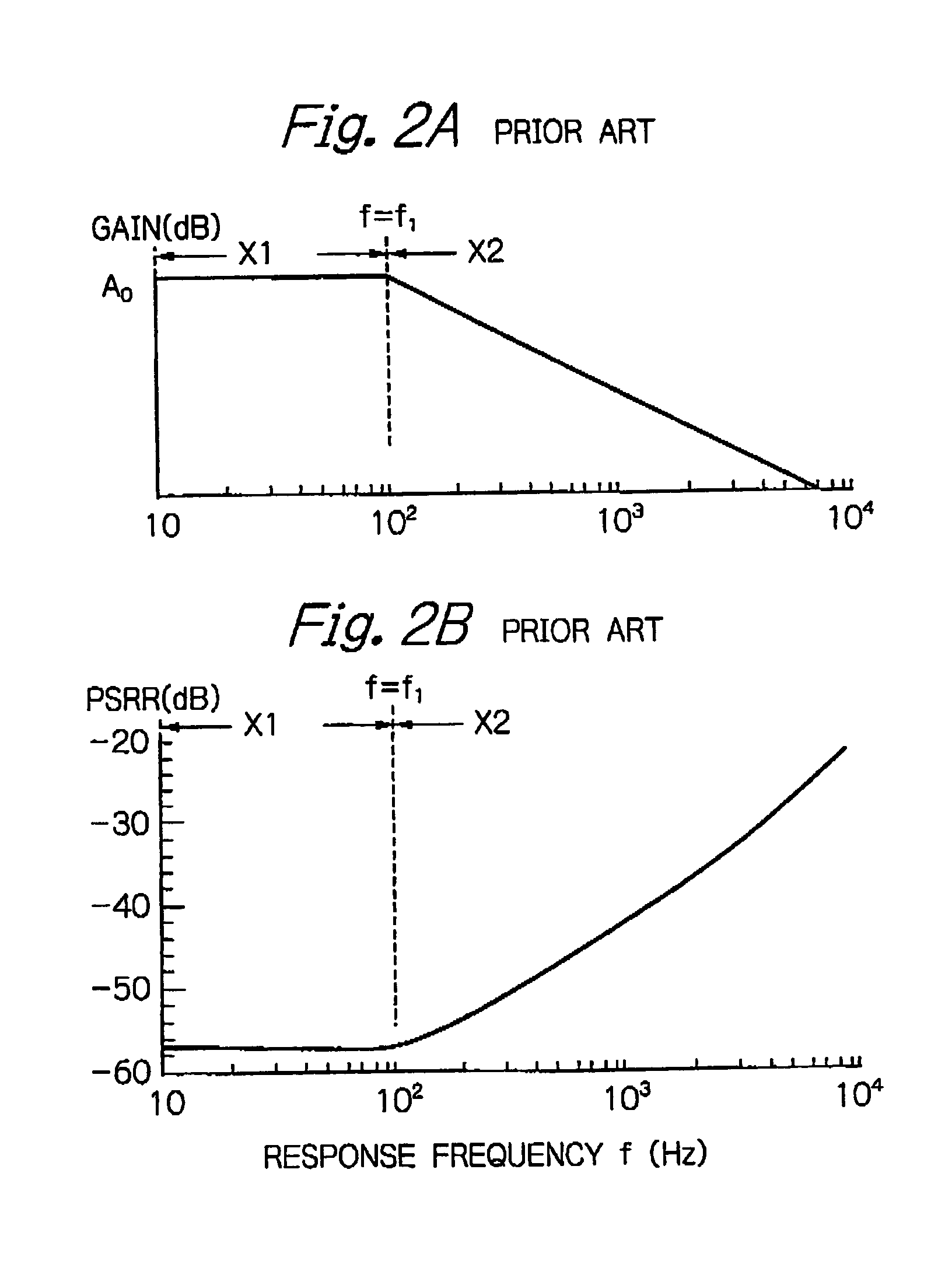Voltage regulator with improved power supply rejection ratio characteristics and narrow response band
a voltage regulator and power supply rejection technology, applied in the field of voltage regulators, can solve the problems of high frequency noise at the output terminal, inability to compensate for negative feedback control, and rapid degradation of psrr characteristics, and achieve the effect of improving psrr characteristics
- Summary
- Abstract
- Description
- Claims
- Application Information
AI Technical Summary
Benefits of technology
Problems solved by technology
Method used
Image
Examples
first embodiment
[0038]In FIG. 5, which illustrates the voltage regulator according to the present invention, a voltage regulator 10 includes a capacitor 7 in addition to the voltage regulator 100 of FIG. 1.
[0039]The gain characteristics of the voltage regulator 10 of FIG. 5 are as shown in FIG. 6A where a response band is limited by the oscillation preventing capacitor 6. Note that since the capacitance of the oscillation preventing capacitor 6 is relatively large, an upper frequency f1 defined by the response band is 80 Hz, for example. Therefore, if a low frequency noise lower than the frequency f1 is applied to the power supply voltage VCC, the negative feedback control using the feedback voltage VFB is carried out to compensate for the low frequency noise, so that the output voltage VOUT is not affected by the low frequency noise.
[0040]On the other hand, the capacitance of the capacitor 7 is determined to pass a high frequency noise higher than the frequency f1 applied to the power supply volta...
second embodiment
[0045]In FIG. 7, which illustrates the voltage regulator according to the present invention, a voltage regulator 20 includes capacitors 21-1, 21-2 and 21-3 associated with switches formed by P-channel MOS transistors 22-1, 22-2 and 22-3, respectively, and a control circuit 23, instead of the capacitor 7 of the voltage regulator 10 of FIG. 5. In this case, the capacitances C1, C2 and C3 of the capacitors 21-1, 21-2 and 21-3 are different from each other, i.e.,
[0046]C123.
[0047]The control circuit 23 is constructed by a voltage detector formed by a P-channel MOS transistor 231 for detecting a source-to-gate voltage of the drive P-channel MOS transistor 5 depending upon the resistance value of the external load 12, a resistor 232 connected to the drain of the P-channel MOS transistor 231, comparators 233 and 234 for comparing a voltage V1 between the P-channel MOS transistor 231 and the resistor 232 with reference voltages VR1 and VR2 (VR1R2), and a gate circuit 235. As a result, when V...
third embodiment
[0048]In FIG. 8, which illustrates the voltage regulator according to the present invention, a voltage regulator 30 includes capacitors 31-1, 31-2 and 31-3, whose capacitances are C0:2C0:4C0, associated with switches (P-channel MOS transistors) 32-1, 32-2 and 32-3, respectively, and a control circuit 33, instead of the capacitor 7 of the voltage regulator 10 of FIG. 5.
[0049]The control circuit 33 is constructed by a voltage detector formed by a P-channel MOS transistor 331 for detecting a source-to-gate voltage of the drive P-channel MOS transistor 5 depending upon the resistance of the load 12, a resistor 332 connected to the drain of the P-channel MOS transistor 331, and an analog / digital (A / D) converter 333 for performing an A / D conversion upon a voltage V1 between the P-channel MOS transistor 331 and the resistor 332 to generate three-bit data (D0, D1, D2). As a result, the switches (P-channel MOS transistors) 32-1, 32-2 and 32-3 are turned ON in accordance with the output signa...
PUM
 Login to View More
Login to View More Abstract
Description
Claims
Application Information
 Login to View More
Login to View More - R&D
- Intellectual Property
- Life Sciences
- Materials
- Tech Scout
- Unparalleled Data Quality
- Higher Quality Content
- 60% Fewer Hallucinations
Browse by: Latest US Patents, China's latest patents, Technical Efficacy Thesaurus, Application Domain, Technology Topic, Popular Technical Reports.
© 2025 PatSnap. All rights reserved.Legal|Privacy policy|Modern Slavery Act Transparency Statement|Sitemap|About US| Contact US: help@patsnap.com



